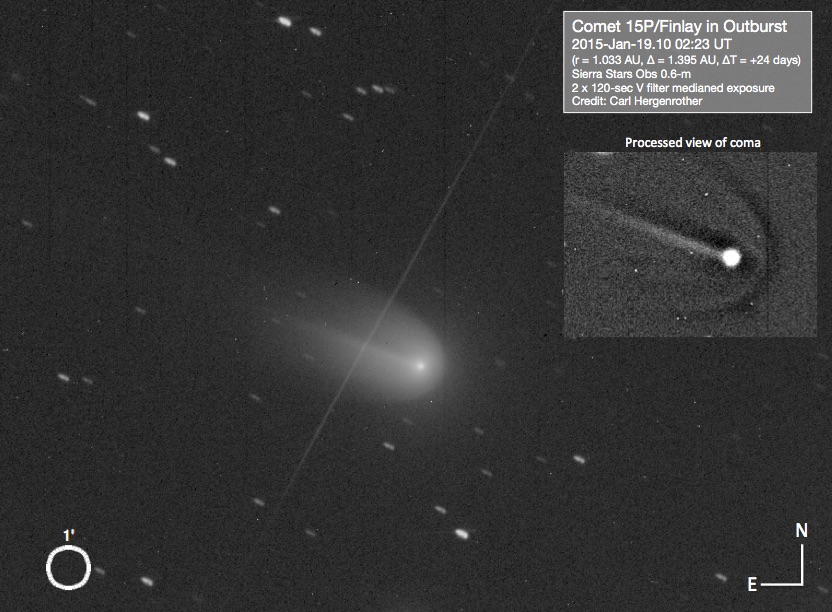ALPO COMET SECTION NEWS FOR FEBRUARY 2015
2015-February-6
Now that the Moon is out of the evening sky, it is once again a great time to observe Comet Lovejoy. Though it has faded it is still a borderline naked eye object for dark sky observers.
Evening Comets
C/2014 Q2 (Lovejoy) [Perihelion on 2015-Jan-30 at 1.29 AU from the Sun]
Lovejoy has been quite the comet. Ever since discovery, the comet has been brightening at a rate much faster than typical. Rather than slow down, its intrinsic brightening has only accelerated throughout January. But all good things must come to an end and with the comet now receding from the Sun (1.29 to 1.37 AU this month) and Earth (0.77 to 1.31 AU) the comet has begun to fade in apparent magnitude. As of February 6th, the comet is a naked eye object at magnitude ~5.0 down from its peak at magnitude ~3.8 in mid-January. It will be interesting to see if the comet fades as rapidly as it brightened. By the end of the month, Lovejoy should still be as bright as magnitude 6.0-7.0. The comet’s motion takes it through Andromeda (Feb 1-13), Perseus (13-14), Andromeda again (14-19) and Perseus again (19-28) this month.
The plot below shows a lightcurve of C/2014 Q2 produced from visual and CCD magnitude measurements submitted to the Section.
Recent ALPO images and observations of C/2014 Q2 (Lovejoy) can be found in the Comet Section Image Gallery and Magnitude Database. Finder charts can be found at the ALPO Comet Finder Chart page.
15P/Finlay [Perihelion on 2014-Dec-27 at 0.98 AU from the Sun]
Outbursting comet 15P/Finlay has done it again. Following its December outburst, the comet experienced another outburst in mid-January when it reached a peak brightness of ~7.5 to 8.0. The comet has rapidly faded since then and is now between magnitude 10 and 11. This is definitely one to watch for further outbursts. Finlay is an evening object moving though Pisces (Feb 1-26) and Aries (26-28).
Recent ALPO images and observations of 15P/Finlay can be found in the Comet Section Image Gallery and Magnitude Database. Finder charts can be found at the ALPO Comet Finder Chart page.
New Discoveries
Four comets were discovered since the last Section update. Each was found by the Pan-STARRS project and were fainter than 19th magnitude. Unfortunately none of them is expected to get brighter than 18th magnitude. Three [C/2015 A1 (PANSTARRS), C/2015 A2 (PANSTARRS), C/2015 B1 (PANSTARRS)] are long-period comets with the fourth [P/2015 A3 (PANSTARRS)] being a short period comet with a period of 22 years.
As always, the Comet Section is happy to receive all comet observations, whether images, drawings or magnitude estimates.
- Carl Hergenrother (ALPO Comet Section Coordinator)





